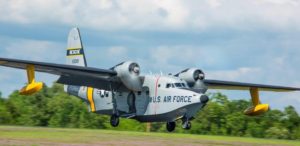Project Description

MPH
WEAPONS
SEATS
Grumman HU-16 Albatross
Role: Air-sea rescue flying boat
National Origin: United States
Manufacturer: Grumman
First Flight: 1949
Primary User: US Air Force, US Coast Guard, US Navy, Hellenic Navy
Number Built: 466
The Grumman HU-16 Albatross is a large twin–radial engine amphibious flying boat that was used by the U.S. Air Force (USAF), the U.S. Navy (USN) and the U.S. CoastGuard (USCG), primarily as a search and rescue and combat search and rescue aircraft. Originally designated as the SA-16 for the USAF and the JR2F-1 and UF-1 for the USN and USCG, it was redesignated as the HU-16 in 1962.
An improvement of the design of the Grumman Mallard, the Albatross was developed to land in open ocean situations to accomplish rescues. Its deep-V hull cross-section and keel length enable it to land in the open sea. The Albatross was designed for optimal 4-foot (1.2 m) seas, and could land in more severe conditions, but required JATO (jet-assisted take off, or simply booster rockets) for takeoff in 8–10-foot (2.4–3.0 m) seas or greater.
General characteristics
- Crew: 4-6
- Capacity: 10 passengers
- Length: 62 ft 10 in (19.16 m)
- Wingspan: 96 ft 8 in (29.47 m)
- Height: 25 ft 10 in (7.88 m)
- Wing area: 1035 ft²[45] (96.2 m²)
- Empty weight: 22,883 lb (10,401 kg)
- Loaded weight: 30,353 lb (13,797 kg)
- Max. takeoff weight: 37,500 lb (17,045 kg)
- Fuel Capacity: 675 US Gallons (2,555 L) internally, plus 400 US Gal (1,514 L) in wingtip floats plus two 300 US Gallon (1,136 L) drop tanks
- Powerplant: 2 × Wright R-1820-76 Cyclone 9 nine-cylinder single-row air-cooled radial engine, 1,425 hp (1,063 kW) each
Performance
- Maximum speed: 205 knots (236 mph, 380 km/h)
- Cruise speed: 108 knots (124 mph, 200 km/h)
- Stall speed: 64 knots (74 mph, 119 km/h)
- Range: 2,478 nmi (2,850 mi, 4,589 km)
- Service ceiling: 21,500 ft (6,550 m)
- Rate of climb: 1,450 ft/min (7.4 m/s)